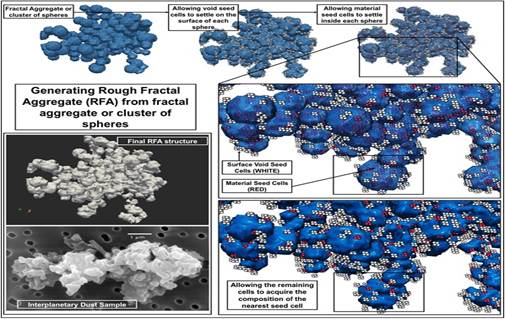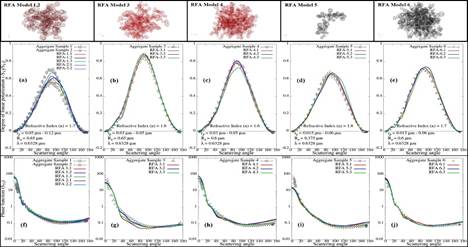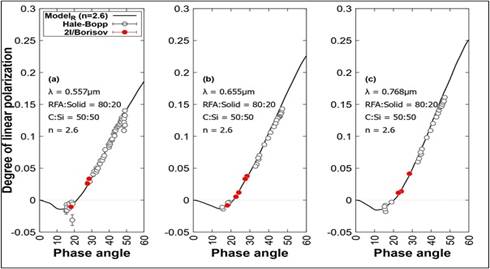Indian scientists develop model cosmic dust particles to mimic the unusual polarisation of interstellar comet 2I/Borisov
State of the art visually realistic cosmic dust model created by scientists to replicate the unusual polarisation properties of the first observed interstellar comet (not gravitationally bound to a star), 2I/Borisov, can reproduce experimental as well as observational data of light scattered by dust. The particles would be useful to determine the physical properties of dust present in different regions of space.
Generally, Solar System comets are categorised in two polarimetric classes: low and high polarisation comets depending on the different dust-to-gas ratio observed in the coma. Apart from these two classes, there exists a third class of comets, having polarisation higher than that of high polarisation comets, which was observed only in case of one Solar System comet, C/1995 O1 (Hale-Bopp). Such steep polarimetric slope is believed to occur due to the presence of small pristine cosmic dust. Polarimetric studies of 2I/Borisov, the first interstellar comet to be observed and studied by mankind, exhibited an unusually steeper slope which was observed only in case of one Solar System comet, C/1995 O1 (Hale-Bopp).

Figure-1: Algorithm for generating visually realistic Rough Fractal Aggregate (RFA)

Figure-2: Variation of the degree of linear polarization -S12/S11 (a-e) and phase function S11 (f-j) with scattering angle for RFA model structures (1-6) (Solid lines) compared with the experimental results for Aggregate Samples (1-6) (hollow squares and triangles) from the Granada Amsterdam Light Scattering Database
To explain the polarimetric observations of comets, it is important to develop realistic computer-modeled dust structures and computationally simulate the scattering of light by such modelled structures.
Recently, scientists from the Indian Institute of Astrophysics (IIA), Bangalore, an autonomous institute of the Department of Science & Technology (DST), Government of India, for the first time developed a visually realistic cosmic dust model using a set of numerical algorithms/software called REST (Rough Ellipsoid Structure Tools). Dr. Prithish Halder, a postdoctoral fellow from IIA, Bangalore, working with Prof. Sujan Sengupta, a scientist at the IIA Bangalore, have crafted surface roughness/irregularities from spheres, superellipsoids and fractal aggregates of spherical grains formed due to coagulation and ballistic agglomeration in the circumstellar or interstellar environment to create the visually realistic cosmic dust particles called agglomerated debris (Solids) and Rough Fractal Aggregates (RFA).

Figure-3: Best fit model results using Model𝑅 for the interstellar comet 2I/Borisov with the observations (red filled circles) at wavelengths 𝜆 = 0.557𝜇m (𝑉𝑓 filter), 0.655𝜇m (𝑅𝑓 filter) and 0.768𝜇m (𝐼𝑓 filter) and compared with the polarimetric observations of the comet C/1995 O1 (Hale-Bopp) (blue filled circles) at 𝜆 = 0.4845𝜇m, 0.620𝜇m and 0.730𝜇m for Carbon:Silicate = 50:50 (n=2.6) (a-c).
The RFA structures were authenticated by replicating light scattering response of circumstellar/cosmic dust analogs from the Granada Amsterdam Light Scattering Database (a database of light scattering parameters obtained from laboratory simulation of light scattering over dust samples). Once the numerical light scattering simulations over RFA structures successfully reproduced the experimental results, a dust model was prepared considering a mixture of RFA structure and Solid particles over a wide range of sizes from few hundred of nanometers to few micrometers having material composition of amorphous silicate (Forsterite) and amorphous carbon, respectively. The best-fit polarisation and the best-fit polarimetric spectral gradient results were obtained for 80% RFA particles and 20% Solids, indicating the presence of a huge population of highly porous pristine cosmic dust particles. The model results also indicate the observed dust-to-gas ratio is directly proportional to the porous-to-compact ratio of the modelled dust structures. The research has been accepted for publication in The Astrophysical Journal, which is published by the American Astronomical Society (AAS).
The ArXiv link to the accepted manuscript is https://doi.org/10.48550/arXiv.2302.13370

